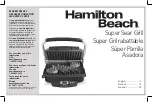
2
2
2. Safety information
• The hose and seal on the regulator must be checked for wear or damage before every use
and before connecting to the gas cylinder (see fig.1).
• Ensure the appliance is used away from flammable materials. Minimum safe distances are
1.2m above the appliance and 600mm to the rear and sides of the appliance (see fig. 2).
• Do not use an appliance that is damaged, leaking, or which does not operate properly.
• Keep gas cylinders away from heat and flames. Do not place on a stove or any other hot
surface.
• Ensure that the assembled unit is stable and does not rock.
• Do not cover or change the primary air supply openings in the burners as this will affect
the performance of the product and may lead to an unstable flame.
• In the event of burn back, (where the flame burns back and ignites at the jet),
immediately turn off the gas supply by first closing the control valve on the gas cylinder
and then the appliance valve. After the flame is extinguished remove the regulator and
check the condition of its seal. Replace the seal if in doubt. Re-light the appliance as
described in Section 3 below. Should the flame light back persistently return the product
to your authorized CADAC repair agent.
• If there is a leak on your appliance (smell of gas), immediately close the control knob on
the gas cylinder. If you wish to check for leaks on your appliance, do it outside. Do not try
to detect leaks using a flame; use soapy water.
• The correct way is to smear the joints with soapy water. If a bubble or bubbles form then
there is a gas leak. Immediately turn off the gas supply firstly by closing the control valve
on the gas container and then the appliance valve. Check that all the connections are
properly fitted. Re-check with soapy water. If a gas leak persists, return the product to your
CADAC dealer for inspection / repair.
• Do not modify the appliance or use it for anything which it has not been designed for.
• During use, part of the appliance will become hot, particularly the cooking areas and
the hood. Avoid touching hot parts with your bare hands. The use of oven gloves is
recommended.
• Keep young children away from the appliance at all times.
• This appliance consumes oxygen and needs ventilation for optimum performance and for
the safety of those in close proximity.
• Do not move the appliance while in use.
• The parts sealed by the manufacturer or its agent must not be altered by the user.
•
Use outdoors only.
NOTE
• Do not twist or pinch the hose. Ensure that it is kept away from the BBQ body so as to
prevent deterioration/damage to the hose caused by heat.
• Fit one end of the low pressure hose onto the regulator nozzle, and the other end onto the
Patio BBQ nozzle by pushing the ends on as firmly as possible. Clamp into position using
a hose clamp at both ends of the hose.
• Ensure that the connections are made securely and do not allow gas to leak.
• Check for gas leaks before using the appliance.
For use with an approved hose and regulator connected to a refillable gas container not
exceeding 11kg and complying with local regulation in force.
• Do not obstruct the ventilation openings of the cabinet.
• Do not modify the appliance. Modifying the appliance may be dangerous.
• Warning: Since this barbecue has no restriction in the emission of unburned gas, this
barbecue must be installed and/or used OUTDOORS or in an AMPLY VENTILATED AREA.
Ensure this BBQ is installed in an AMPLY VENTILATED AREA, the area must have at least
25% of the surface (sum of the walls surface) area open.
• Do not move the appliance during use.
• Any modification of the appliance may be dangerous
• Warning: An LP cylinder not connected for use, shall not be stored in the vicinity of this or
any other appliance.
Fig. 1
Country name abbreviations
AT=Austria
DK=Denmark
GB=UnitedKingdom
NO=Norway
BE=Belgium
ES=Spain
IE=Ireland
PL=Poland
CH=Switzerland
FI=Finland
IT=Italy
PT=Portugal
DE=Germany
FR=France
NL=Netherlands
SE=Sweden
SI=Slovenia
Fig. 2
GB
503-0604 LEV7 (98250-31, 98250-33, 98251-43) Cadac Entertainer 3 & 4 - User Manual (EU & SA).indd 2
08/09/2017 11:56:19
























